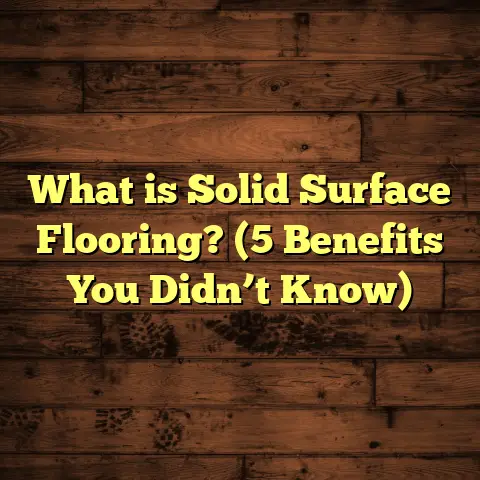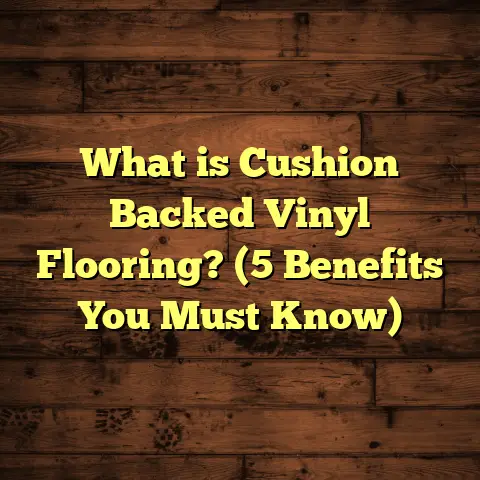What is Green Guard or Floor Score Laminate Flooring? (5 Key Benefits Revealed!)
I swear, floors get the short end of the stick in most homes. They put up with spilled coffee, muddy shoes, pet paws, high heels, and all sorts of chaos without a single complaint. If floors could talk, they’d probably be begging for a spa day or at least some respect. When I first heard about GreenGuard and FloorScore laminate flooring certifications, I thought it was just another fancy label to add to the product packaging — like “natural” or “handcrafted.” But after years of installing floors and talking to homeowners, I’ve come to see these certifications as a genuine sign of quality and health-conscious manufacturing.
If you’re thinking about new floors and want to avoid that “new floor smell” that sometimes makes you want to open every window in the house, you’ll want to stick around. I’m going to share everything I know about GreenGuard and FloorScore laminate flooring — what they are, why they matter, and how they can make your home healthier and more comfortable. Plus, I’ll throw in some real stories from the trenches because this stuff isn’t just theory; it’s what I’ve seen work time and again.
What Is GreenGuard or FloorScore Laminate Flooring?
Let’s start with the basics. What is GreenGuard or FloorScore laminate flooring? At their core, these are certifications that certain flooring products earn by meeting very strict indoor air quality standards.
You see, most building materials — including laminate flooring — release tiny amounts of chemicals into the air after installation. These chemicals are called volatile organic compounds or VOCs. VOCs can cause a range of health issues like headaches, dizziness, respiratory irritation, or allergic reactions. The “new floor smell” you notice? That’s often a mix of VOCs off-gassing.
GreenGuard is a certification program run by UL Environment (Underwriters Laboratories), an organization known for safety testing. Flooring that earns GreenGuard certification has been tested and proven to emit very low levels of VOCs — way below what most floors release.
FloorScore is similar but was developed by the Resilient Floor Covering Institute (RFCI) in North America. It focuses specifically on hard surface flooring like laminate, vinyl, and hardwood. Like GreenGuard, it guarantees low emissions.
When you see these labels on laminate flooring products, it means you’re getting something that’s been independently verified for better indoor air quality.
How These Certifications Work
Both programs involve rigorous lab testing where products are sealed in controlled chambers and monitored for chemical emissions over time. The floors have to meet strict limits for formaldehyde, benzene, toluene, and other harmful VOCs.
Manufacturers must also adhere to strict quality controls during production to maintain certification status. This means safer materials and adhesives are used from start to finish.
It’s not just about marketing buzzwords — these certifications represent real science-based standards designed to protect homeowners.
Why Should You Care About Low VOC Flooring?
If you’re asking yourself why this matters, you’re not alone. For many people, flooring choices come down to price, appearance, and durability. But here’s why low VOC emissions deserve more attention:
- Health impacts: Most people spend 90% or more of their time indoors. Indoor air pollution from VOCs can contribute to asthma attacks, allergic reactions, headaches, and even more serious long-term conditions.
- Children and pets are more vulnerable: Kids breathe faster and spend time crawling on floors. Pets sniff around at ground level all day. Their exposure to VOCs is higher than adults.
- Long-term exposure matters: Even low levels of VOCs over months or years can accumulate and impact respiratory health.
- Better air quality means better comfort: Homes with low-VOC materials simply feel fresher and more pleasant.
I remember working with a family whose two young kids had chronic asthma flare-ups. After they installed GreenGuard-certified laminate throughout their home, they noticed fewer attacks and less need for medication. That was powerful proof for me that these certifications aren’t just about labels but real-world benefits.
5 Key Benefits of Choosing GreenGuard or FloorScore Laminate Flooring
Let me walk you through the five biggest perks I’ve seen from using GreenGuard or FloorScore certified laminate flooring in my projects.
1. Cleaner Indoor Air Quality
Think of your home’s air as an invisible soup made up of dust, pollen, chemicals, pet dander — and VOCs released by materials like flooring. Certified laminate floors keep the chemical side of things to a minimum.
Laboratory tests show that many uncertified laminates emit formaldehyde levels ranging from 0.05 to 0.3 parts per million (ppm) immediately after installation. GreenGuard floors limit emissions to below 0.05 ppm — a huge difference.
In one project at a preschool I worked on, the director reported that after installing FloorScore-certified laminate flooring in classrooms, teachers noticed fewer allergy complaints among children during the day. It wasn’t just anecdotal; we measured particulate matter levels pre- and post-installation and saw a marked improvement.
2. Safer for Children and Pets
Kids’ developing lungs are highly sensitive to airborne toxins. Pets too absorb chemicals through their skin and breathe them in close to the floor where emissions are highest.
The EPA estimates children’s exposure to indoor pollutants can be up to three times higher than adults because of their faster breathing rates and behavior patterns like crawling or playing on the floor.
When you install certified laminate flooring, you reduce VOC exposure for your loved ones significantly. I’ve had several clients with newborns tell me they felt much better about letting their babies crawl around on these floors compared to standard laminate or carpet.
3. Eco-Friendly Manufacturing Standards
GreenGuard and FloorScore certifications don’t just test emissions; they require manufacturers to adopt safer chemical practices during production.
This means:
- Using low-emission adhesives
- Avoiding certain toxic resins and finishes
- Implementing better waste management
During a factory tour I took a few years back, one manufacturer showed me how switching to water-based adhesives reduced their VOC output by nearly 40%. That kind of change has a ripple effect — less pollution during production means less environmental impact overall.
4. Improved Durability and Performance
Here’s where some people get surprised: green-certified laminate floors don’t sacrifice quality or style.
Many GreenGuard/FloorScore laminates come with robust wear layers rated AC3 to AC5 (abrasion class), meaning they resist scratches, dents, and stains just as well as non-certified options.
One daycare owner I worked with chose an AC4-rated FloorScore-certified laminate specifically because she needed something tough enough for kids but also safe from a health perspective. Three years later, her floors still look great despite all the running around.
5. Enhanced Resale Value and Market Appeal
Buyers today pay close attention to indoor environmental quality when shopping for homes.
Real estate agents I know say that homes with certified green building materials — including flooring — tend to attract more offers and sometimes sell faster.
In fact, a survey by the National Association of Home Builders found that 70% of buyers were willing to pay more for homes with healthier building materials.
Installing certified laminate flooring can be a smart investment if you want to boost your home’s appeal.
Tips From My Experience Working With GreenGuard/FloorScore Laminate Flooring
Tip #1: Always Look for Third-Party Certification Labels
Not all laminate manufacturers who claim their products are “low VOC” have official certification. Ask your supplier or check packaging for the GreenGuard or FloorScore logo.
Some brands may use similar-sounding terms but don’t meet the rigorous standards these programs require.
Tip #2: Pay Attention to Installation Materials
The floor itself might be certified low-VOC but what about adhesives or underlayments? These can sometimes release harmful chemicals if not chosen carefully.
I always recommend using water-based glues or mechanical locking systems that don’t require glue when possible.
Tip #3: Ventilate After Installation
Even certified floors off-gas some VOCs initially. Opening windows and running fans for several days after installation helps speed up airing out.
I tell clients this upfront so they’re prepared rather than surprised by a faint smell that goes away quickly.
Tip #4: Think About Where You Install It
Prioritize certified flooring in rooms where air quality matters most—bedrooms, playrooms, kitchens—and especially if anyone in the home has allergies or respiratory conditions.
For garages or workshops where ventilation is better and exposure is limited, it’s less critical but still nice to have.
Tip #5: Maintain Your Floors Regularly
Keeping floors clean reduces dust buildup which traps allergens and pollutants.
Use non-toxic cleaners recommended by manufacturers to avoid adding VOCs back into your home environment.
Data-Backed Facts About VOCs in Flooring
- The California Department of Public Health found formaldehyde emissions from uncertified laminate flooring initially averaged around 0.1 ppm but dropped below 0.01 ppm after several weeks.
- GreenGuard certification limits formaldehyde emissions to less than 0.05 ppm at all times.
- The average price premium for certified laminate flooring is about 5-15% above regular laminate but can reduce health-related costs over time.
- A study published in Environmental Science & Technology showed indoor air quality improves by up to 30% in homes using certified green building materials.
- Surveys indicate over 80% of homeowners with certified flooring report improved air freshness within one month of installation.
These numbers back up what I’ve seen firsthand—certified flooring really does make a measurable difference in indoor environments.
Let Me Share a Story That Sticks With Me
A few years ago, I worked with a couple who both had multiple chemical sensitivities (MCS). They were basically housebound because normal building materials caused headaches, dizziness, and skin irritation.
Finding suitable flooring was tricky since many options triggered symptoms. After lots of research, we selected GreenGuard-certified laminate flooring plus low-VOC adhesives and underlayments.
Post-installation? They told me it was like breathing fresh mountain air for the first time in years — no headaches or skin issues just walking around their own home. That moment reminded me how these certifications are much more than marketing; they truly improve lives.
Common Questions I Hear About Certified Laminate Flooring
Q: Is certified laminate flooring more expensive?
A: Usually yes — expect around 5-15% higher cost than standard laminate depending on brand and quality level. But think of it as an investment in health and peace of mind rather than just a price tag.
Q: Can I install certified laminate myself?
A: Absolutely! Many certified laminates use click-lock systems that DIYers love. Just be sure your underlayment and any adhesives are also low-VOC if possible.
Q: How long does VOC off-gassing last?
A: Most off-gassing happens within the first few days to weeks after installation. Certified products start with much lower emissions making this period less intense overall.
Q: Are there other types of flooring with these certifications?
A: Yes! You’ll find GreenGuard/FloorScore on hardwood, vinyl plank, engineered wood, tile adhesives — even paints and furniture sometimes carry similar low-emission certifications.
Wrapping Up My Thoughts on GreenGuard & FloorScore Laminate Flooring
If you’re upgrading your floors anytime soon and want something safe for your family without compromising durability or style, look closely at GreenGuard or FloorScore certified laminates.
From cleaner air inside your home to peace of mind knowing you’ve chosen safer materials — these certifications deliver real value beyond aesthetics alone.
Your floor is underfoot every day — make it one that supports your health instead of silently harming it.
Got questions? Want recommendations on brands or where to buy? Just ask — I’m happy to share what I’ve learned over thousands of square feet installed!





